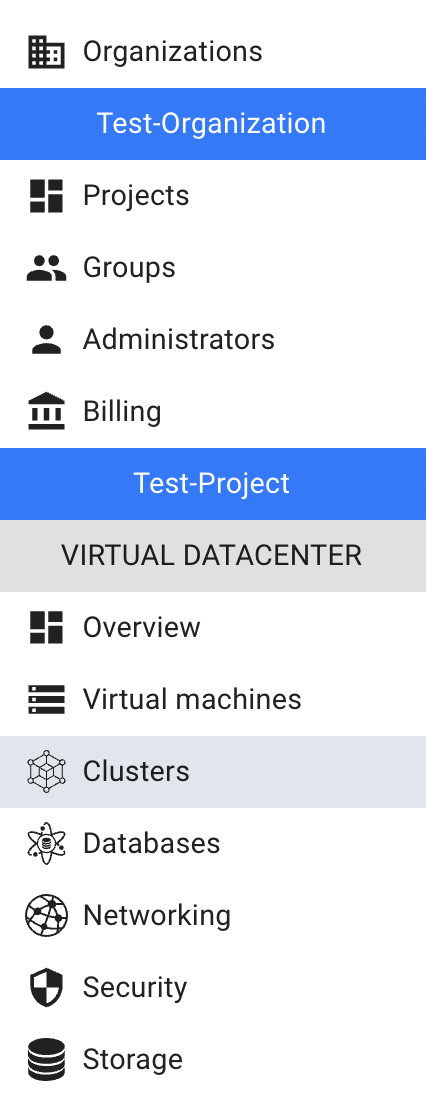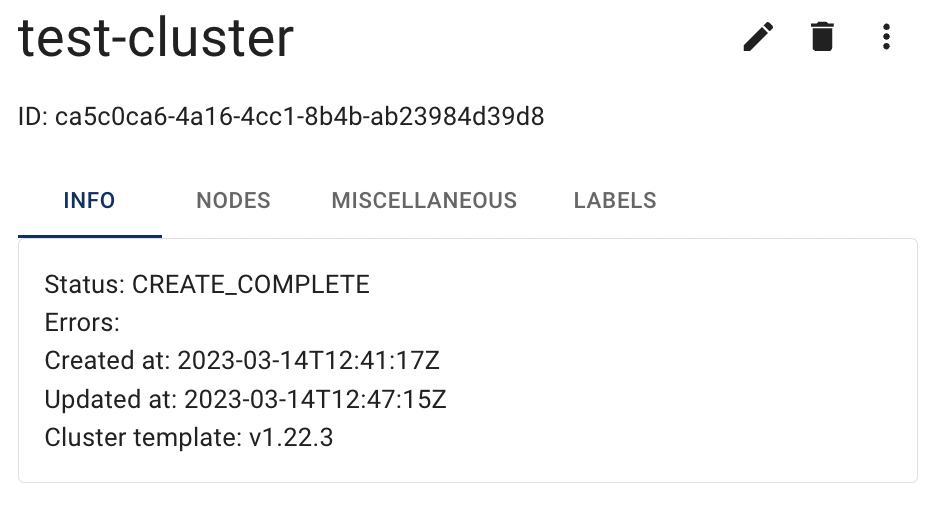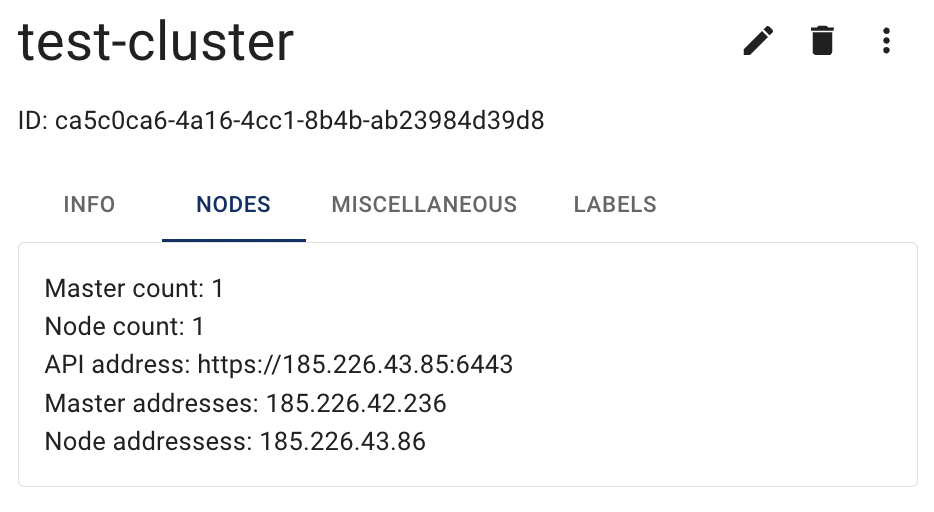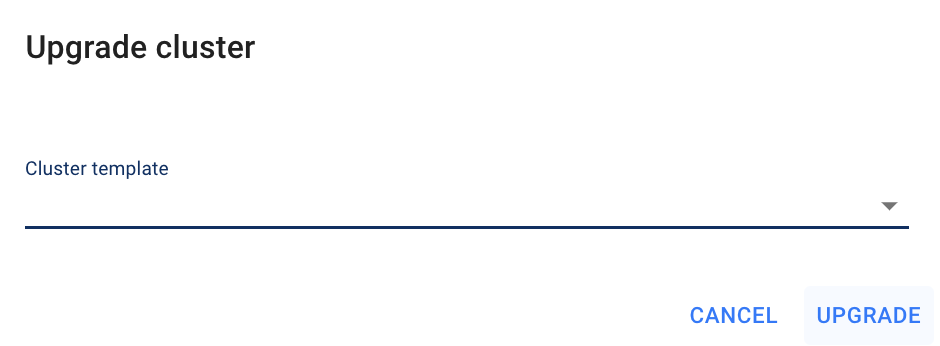K8S Cluster
On this page, you can find an explanation of how to create, resize, delete Kubernetes Cluster and instructions for other steps to manage Kubernetes Cluster in the Cloud Console.
Table of contents
Clusters page
To get to the Clusters page, select the Clusters from the VIRTUAL DATACENTER block in the side-bar menu:

On this page you can find all created Kubernetes Clusters in the current Project of the selected Organization, with the Create button, Search bar and Actions icon which opens a list of available management actions for the selected Cluster:

Actions icon opens the next list of available management actions:
- Download kubeconfig file - this option is used to get the kubeconfig file, that pertains to the selected Cluster;
- Edit - this option is used to change the count of Worker-nodes in the selected Cluster;
- Delete - this option is for Cluster removing.
Create Cluster
To create new Cluster, do the following:
- go to the Clusters page and click on the CREATE CLUSTER icon in the upper left corner;
- fill in the form on the next opened Create Cluster window and click on the CREATE icon:

- Name - set a name for the Cluster;
- Cluster Template - select the template that will be used to create Cluster;
by default, the newest one is pre-selected; - Master Flavor - select the size of the Cluster master-nodes (min is VC-2);
by default, “VC-4 (2 vCPUs, 4 GiB memory)” is pre-selected; - Node Flavor - select the size of the Cluster worker-nodes (min is VC-2);
by default, “VC-4 (2 vCPUs, 4 GiB memory)” is pre-selected; - Key pair - select the SSH Keypair that was previously created on the Keypair page or create a new one;
SSH Keypair you will use to configure in the Cluster servers for ssh access;
if you have only one created SSH Key, it will be pre-selected by default; - Docker image size (GB) - provide the preferred disc size where container images will be stored, it can be specified in the range from 50 GB to 1000 GB;
by default, 50 GB is pre-selected; - Master Count - set how many master-nodes the Cluster will contain;
by default, 1 is pre-selected; - Node Count - set how many worker-nodes the Cluster will contain;
by default, 1 is pre-selected;
And the last field you can make a marks:
- Enable auto-scaling - if you choose to enable this option, please set the limits of node count; the max count is 10 nodes;
- Accessible on private network only.
After these steps, the newly created Cluster will be added to the Clusters page with the status CREATE_COMPLETE (Estimate creation time about 5 minutes).
Cluster details page
To open the Cluster details page, click on the Name of the corresponding Cluster:

This action will redirect you to the Cluster details page, where you can find four tabs with additional information about selected Cluster and panel with available quick actions:
- panel with available quick actions include all available management actions with this cluster such as: edit (resize), delete and download kubeconfig file:

- INFO Tab with actual information about this Cluster: ID, Current Status, Errors, Creation Date, Date of the last update and Cluster template:

- NODES Tab with actual information about Cluster’s Nodes: Master and Node count, their IP addresses and API address of the Cluster:

- MISCELLANEOUS Tab with next information: Discovery URL, Cluster create timeout, Key pair that was used during the Cluster creation, Master and Node flavors, and current Health status of the selected Cluster:

- LABELS Tab with some additional information about this cluster:

Download kubeconfig file
The kubeconfig file is required to configure access to a cluster and switch between multiple clusters, multiple users, and with different authentication mechanisms such as passwords or tokens.
To download the kubeconfig file that pertains to Cluster, do the following:
- identify this desired Cluster on the Clusters page;
- click on the Actions icon and select the Download kubeconfig file in the list of available options.
After these steps, the kubeconfig file will be downloaded.
Also, you can download the kubeconfig file from Cluster details page, by clicking on the appropriative quick actions icon there:

Resize Cluster
To resize the Cluster, do the following:
- identify the Cluster, that you want to resize, on the Clusters page;
- click on the Actions icon and select the Edit in the list of available options;
- update the count of Worker-nodes in the Cluster on the opened Edit Cluster window and click on the SAVE icon:

After these steps, the selected Cluster will be resized after a few minutes with the status UPDATE_COMPLETE.
Also, you can resize the Cluster from Cluster details page, by clicking on the appropriative quick actions icon there:

Upgrade Cluster
For cluster upgrading you can select only a version that is higher than current one.
To upgrade the Cluster, do the following:
- identify the Cluster, that you want to upgrade, on the Clusters page;
- click on the Actions icon and select the Upgrade in the list of available options;
- select the version to which you want to upgrade the selected Cluster on the opened Upgrade Cluster window and click on the UPGRADE icon:

After these steps, the selected Cluster will be upgraded after a few minutes with the status UPDATE_COMPLETE.
Also, you can upgrade the Cluster from Cluster details page, by clicking on the appropriative quick actions icon there:

Delete Cluster
To delete the Cluster, do the following:
- identify this unnecessary Cluster on the Clusters page;
- click on the Actions icon and select the Delete in the list of available options;
- confirm the Cluster deletion on the next opened Confirmation window.
After these steps, the selected Cluster will be deleted after a few minutes.
Also, you can delete the Cluster from Cluster details page, by clicking on the appropriative quick actions icon there:
